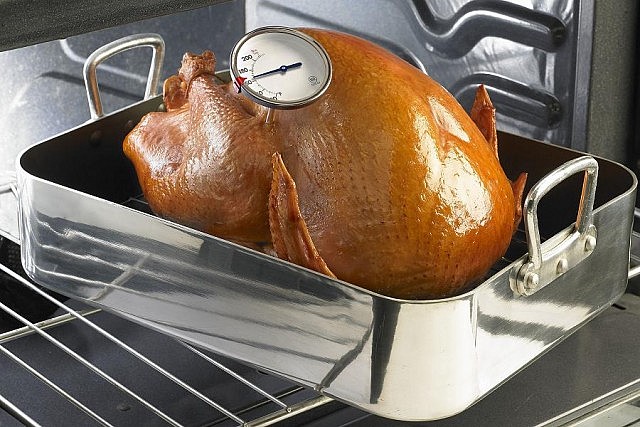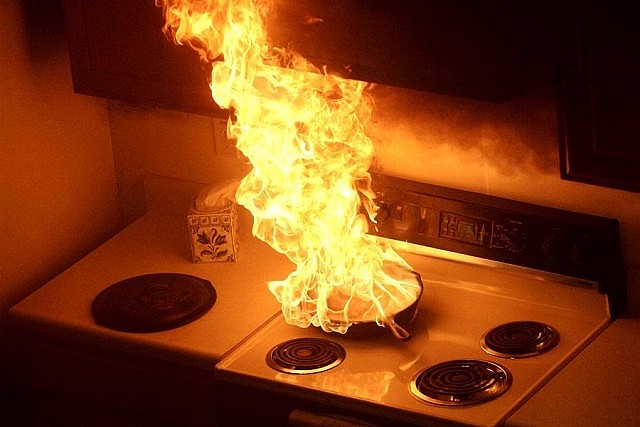While the holiday season is an ideal time for entertaining family and friends, there’s always a chance something can go wrong when lots of people get together — whether it’s from a guest with the flu, an undercooked turkey, or a kitchen fire. Here are some tips to help ensure everyone has a safe and healthy holiday.
Flu Safety

The flu on the rise across Ontario and you don’t want to get it, especially over the holidays. The flu can leave people ill for up to seven days and can lead to serious health problems such as pneumonia. When you get the flu, you can infect others a day before your own symptoms even appear, and you remain contagious for up to a week after you get sick.
One of the best ways to reduce your chance of getting the flu is to get a flu shot. Not only does the flu shot help prevent you from getting sick, but it also prevents you from spreading the flu virus to seniors, young children, pregnant women, and people with weakened immune systems — those who are at the greatest risk of getting seriously ill if they get the flu.
The flu shot — which is recommended for everyone over six months of age — is widely available at many local pharmacies, from doctors’ offices, and from local walk-in clinics. Children and youth can also get the flu vaccine through a nasal spray rather than a shot.
Even if you get a flu shot right now, it takes two weeks for your body to develop the antibodies necessary to fight the virus. To reduce the risk of contracting the flu over the holidays, also follow these simple rules:
- wash your hands often with soap and water for at least 15 seconds (if you use a hand sanitizer, make sure it’s a least 60% alcohol)
- cover your mouth and nose with a tissue when you cough or sneeze, and throw out the tissue when you’re done (if you don’t have a tissue, cough or sneeze into your upper sleeve rather than your hand)
- avoid touching your face with your hands (the flu virus usually enters your body through the eyes, nose, or mouth)
- stay at home when you’re sick (your friends and family will understand and will thank you)
- clean and disinfect germ-spreading surfaces, including gloves, purses, phones, door handles, and countertops.
Remember that the flu virus can live on your hands for up to three hours, and on surfaces for up to eight hours!
If you or a family member do get the flu, you can go to the Emergency Department if necessary. To prepare for an expected increase in the number of patients during flu season, the Peterborough Regional Health Centre (PRHC) at 1 Hospital Drive will be opening and staffing an additional 24 inpatient beds from December 2015 until March 2016.
If you decide to go to the Emergency Department, please wear a mask if you’re coughing and sneezing to protect others from potential flu exposure. Masks are available inside the Emergency Department entrance at PRHC.
If you don’t feel you need urgent medical attention, there are options to consider other than a visit to the Emergency Department. Family doctors and nurse practitioners will be offering same-day appointments and extended-hours clinics. You can also speak to a registered nurse by calling Telehealth Ontario, which is available 24 hours, at 1-866-797-0000.
If your kids become unwell over the holidays and you’re unable to get an appointment elsewhere, PRHC’s Pediatric Out Patient (POP) Clinic will be holding an Urgent Care Clinic that’s run by a nurse practitioner and supported by an on-call pediatrician.
The Urgent Care Clinic, located in the POP Clinic on the 6th floor of PRHC, will be open from 8 a.m. to 3 p.m. on Wednesday, December 23rd, Thursday, December 24th, and Thursday, December 31st. It will be open from 8 a.m. to 6 p.m. on Monday, December 28th, Tuesday, December 29th, and Wednesday, December 30th.
Food Safety

Safe food handling skills are especially important when many holiday meals and gatherings are being planned. Food that becomes contaminated due to improper food handling or undercooking can make people sick, spoiling what is supposed to be a happy holiday.
Wash your hands, utensils, and surfaces with hot soapy water before, during, and after food preparation. Especially if you’re working with raw meat, sanitize countertops, cutting boards, and utensils with a mild bleach and water solution. Wash all produce thoroughly before preparing, eating, or cooking.
If preparing a frozen turkey for a holiday meal, start thawing it in the fridge several days before roasting. Allow 24 hours of defrosting time for every 2.5 kg (5 pounds) of turkey. Place the thawing turkey on a plate or tray to prevent the leaking juices from contaminating other foods in the fridge. Never thaw a turkey on the kitchen counter.
The goal of cooking a turkey is to reach a high enough internal temperature (82°C/180°F) to kill bacteria. Rather than checking for the juices to run clear to let you know the turkey is done, it’s better to use a probe thermometer to check the internal temperature of the turkey. The best place to check the temperature is the inner thigh, just above the bone. Stuffing should be cooked outside the turkey and should reach a temperature of 74°C (165°F).
Cook foods thoroughly and serve immediately. Keep hot foods hot by using warming trays, chafing dishes, or slow cookers that measure at least 60°C (140°F). Keep cold foods cold by resting serving dishes on crushed ice.
If travelling with food, ensure hot foods stay in insulated containers to keep a 60°C (140°F) temperature. Reheat thoroughly before serving. Put cold foods in a cooler with ice or freezer packs to keep them at 4°C (40°F) or lower.
When serving food, use small bowls or trays. This helps to ensure the temperature of food remains even, and also prevents food from being left out too long.
Remember the two-hour rule when entertaining guests with a large meal or buffet. Perishable foods should not be left out at room temperature for longer than two hours. “When in doubt, throw it out!”
While unpasteurized apple cider is a popular holiday beverage, it may contain E. coli. To be sure cider is safe, buy cider that is labelled as being pasteurized.
Leftovers should be cooled quickly and promptly refrigerated. Avoid leaving turkey sitting out for snacking after a meal. Use leftover turkey and other cooked dishes within four days. Never use leftovers as leftovers.
Fire Safety

December is traditionally one of the months of the year with the highest incidence of fatal fires, often because people let their guard down and get distracted by the hustle and bustle of the holidays. Some precautions will help avoid a holiday celebration turning tragic.
If you have a natural Christmas tree, keep the base of the trunk in water at all times. Keep the tree away from any ignition source such as the fireplace, heaters, or candles.
Check all sets of lights before decorating. Before you put lights on the tree or around the front window, check the cords closely. Discard any sets that are frayed or damaged.
Make sure you have working smoke alarms on every level of your home and outside all sleeping areas. With family and friends spending extra time at your home over the holidays, make sure you check your smoke alarms. Test your alarms to make sure they will alert you and your family if a fire occurs, giving you the precious seconds you need to safely escape.
Make sure you have working carbon monoxide alarms. Carbon monoxide is an invisible, odourless gas that can quickly kill you. Installing carbon monoxide alarms in your home will alert you to the presence of this deadly gas. Carbon monoxide alarms are required by law in every Ontario home that has a fuel-burning appliance like a gas furnace or gas water heater, or an attached garage. Like fire alarms, it’s best to install carbon monoxide alarms on every level of your home.
Make sure everyone knows how to get out safely if a fire occurs. Develop and practise a home fire escape plan with all members of the household and make sure someone helps young children, older adults or anyone else that may need assistance to evacuate. Once outside, stay outside and call 911 from a cell phone or neighbour’s house.
Use extension cords wisely. People often use extension cords for that extra set of lights or the dancing Santa in the corner. Extension cords should be used only as a temporary connection. Make sure cords never go under rugs, as this can cause damage to the cord and cause a fire.
If you’re using space heaters, remember to keep them at least one metre (3 feet) away from anything that can burn such as curtains, upholstery, or holiday decorations.
Be very careful when burning candles. While they can set the perfect mood for a holiday celebration, always blow out candles before leaving the room or going to bed. Keep lit candles safely away from children and pets and anything that can burn, such as curtains, upholstery, or holiday decorations.
Keep matches and lighters out of the sight and reach of children. People often keep matches and lighters handy to light holiday candles, but they can be deadly in the hands of children. If you smoke, have only one lighter or book of matches and keep them with you at all times.
Always stay in the kitchen when cooking, especially if using oil or high temperatures. Cooking fires most commonly occur when cooking is left unattended. If a pot catches fire, carefully slide a tight-fitting lid over the pot to smother the flames and then turn off the heat.
Encourage smokers to smoke outside. Careless smoking is the leading cause of fatal fires. If you do allow smoking indoors, use large and deep ashtrays that can’t be knocked over and make sure cigarette butts are properly extinguished.
With all the festive cheer this time of year, keep a close eye on anyone attempting to cook or smoke while under the influence of alcohol. Alcohol is all too often a common factor in many fatal fires.
12 Days of Holiday Fire Safety – 3 Minutes of Holiday Havoc
Sources: Ontario Ministry of Health and Long-Term Care; Peterborough County-City Health Unit; Peterborough Networked Family Health Team; Peterborough Regional Health Centre; Haliburton, Kawartha, Pine Ridge District Health Unit; Ontario Association of Fire Chiefs



























